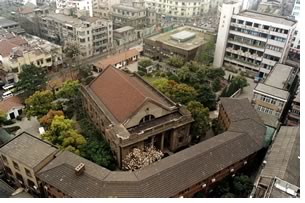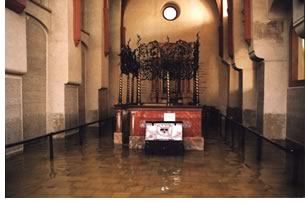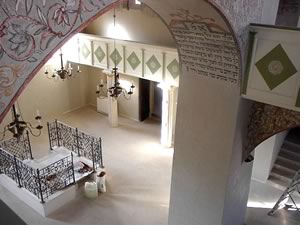

Recipients include Prague Synagogue damaged by recent floods
The World Monuments Fund, through its Jewish Heritage Grant Program and the Ronald S. Lauder Foundation, announces $235,900 in grants to begin or sustain restorations of 13 historically significant synagogues in 11 countries that have deteriorated or fallen into ruin. For the first time, the groups awarded grants to synagogues in Russia, Georgia, Germany, Portugal, Brazil, and China, expanding the geographic scope of the program. Projects in Hungary and Ukraine that had been supported by earlier funding received a second grant toward their completion. The grants, which come from private U.S. foundations and individuals, support master planning, studies, onsite conservation, technical assistance, interpretation, educational programming, and emergency stabilization.
Tifereth Israel de Nilopolis (1928): The oldest synagogue in Rio de Janeiro, built by refugees from Eastern Europe, formed a center of Jewish life and home to the first Yiddish theater in Brazil. Following preservation, it will become a Jewish community center and functioning synagogue. It will receive $12,000 to begin conservation work, and Brazilian cultural agencies will match the funds 5:1.
 Ohel
Rachel Synagogue, China (1917–20): During World War II, more
than 20,000 Jewish refugees escaped to Shanghai, thanks to the city’s
no-visa policy. This site, currently serving the local Jewish community,
is representative of synagogues that previously existed in Shanghai. It
will receive $22,500 for the highest priority work in the first phase
of its restoration plan.
Ohel
Rachel Synagogue, China (1917–20): During World War II, more
than 20,000 Jewish refugees escaped to Shanghai, thanks to the city’s
no-visa policy. This site, currently serving the local Jewish community,
is representative of synagogues that previously existed in Shanghai. It
will receive $22,500 for the highest priority work in the first phase
of its restoration plan.
Jicin Synagogue, Czech Republic (1780): The synagogue, located in an historic Bohemian town, served as a storehouse after World War II and was neglected until it was returned to the Jewish community in 2001. Although in need of conservation, the original Aron ha-Kodesh, or Holy Ark, survived, along with other rare 18th-century elements. It will receive $11,400 for conservation of the ark.
 Pinkas
Synagogue, Czech Republic (1535): This Late-Gothic structure is
the second oldest site in Prague’s historic Jewish district, the
Josefov. The names of 80,000 Czech Jews lost during the Holocaust were
inscribed on interior walls. The synagogue and its memorial suffered damage
during the recent flooding of Prague, and will receive $28,000 for repairs.
Pinkas
Synagogue, Czech Republic (1535): This Late-Gothic structure is
the second oldest site in Prague’s historic Jewish district, the
Josefov. The names of 80,000 Czech Jews lost during the Holocaust were
inscribed on interior walls. The synagogue and its memorial suffered damage
during the recent flooding of Prague, and will receive $28,000 for repairs.
Tbilisi Synagogue, Georgia (1901–03): This landmark of the Tbilisi historic district, endangered for years, recently suffered further damage from a recent earthquake. It will receive $15,000 for emergency stabilization.
Voehl Synagogue, Germany (1827–29): This outstanding example of the rural wooden synagogues of Germany is a rare survivor of Kristallnacht. Once restored, it will serve as a memorial and museum of pre-1943 Jewish life in Voehl. It will receive $15,000 for interior restoration.
Mád Synagogue, Hungary (1775): One of the earliest synagogues in Hungary, this structure is the only survivor of its kind in the Tokaj Hegyalja wine-producing region. It contains original elements of significant artistic and historic merit, and will receive $25,000 for interior conservation. Funds will be matched 1:1 by the Hungarian government.
 Norsa
Synagogue, Italy (18th century): This landmark bears witness to
the splendid history and traditions of the Jewish community in Mantua
during and following the reign of the Gonzagas. Norsa, the only functioning
synagogue in Mantua, will receive $20,000 for conservation of the interior.
Norsa
Synagogue, Italy (18th century): This landmark bears witness to
the splendid history and traditions of the Jewish community in Mantua
during and following the reign of the Gonzagas. Norsa, the only functioning
synagogue in Mantua, will receive $20,000 for conservation of the interior.
White Stork Synagogue, Poland (1829): This is one of the few preserved synagogues in Poland. The Jewish community in Wroclaw, once home to many famous rabbis and scholars, owns the building and worships there. The Classic synagogue by Karl F. Lanhas (who also designed the ark), will receive $12,000 for conservation of paintings on the ark.
Poland and Lithuania Mission: The grant will fund needs assessments of five synagogues: the Big Synagogue in Poland and the Vilnius Synagogue, Kalvarija Synagogue, and Big and Little Synagogues in Lithuania. It will receive $3,000 for assessment of the buildings.
Shaaré Tikva, Portugal (1902–04): The active local Jewish community is sponsoring the preservation of this historically significant synagogue that served as a center of Jewish life in Lisbon, receiving thousands of refugees passing through Portugal during World War II. It will receive $15,000 for interior restoration.
House of the Jewish Society, Russia (1881): In 1991, the Jewish community gained ownership of the only synagogue in Irkutsk. After the building is restored, it will serve as a Jewish community center and an active house of worship. It will receive $15,000 for emergency stabilization.
Tyumen Synagogue, Russia (1911–15): The synagogue, built at the beginning of World War I in West Siberia, has been largely restored, but is now endangered by water penetration of its foundation and needs immediate repairs. It will receive $18,000 for waterproofing of the foundation.
Zhovkva Synagogue, Ukraine (1692): Built in a royal town of architectural interest, this monumental synagogue was an important center of Jewish studies and practice in the 17th and 18th centuries. It will receive $24,000 for interior restoration.
In addition to the preceding grants, during 2002 the Jewish Heritage Grant Program funded two previously supported projects: Paradesi Synagogue in Cochin, India, and Tsori Gilod Synagogue in L’viv, Ukraine. Both received an additional $4,000 this year to advance their restorations.
Copyright 2003 The American Institute of Architects.
All rights reserved. Home Page ![]()
![]()
 |
||
|
|
||